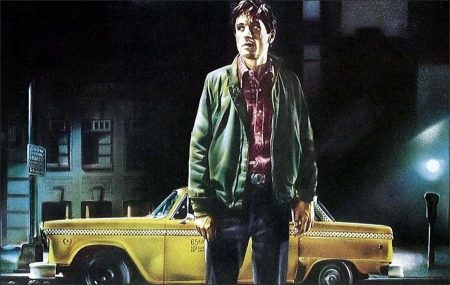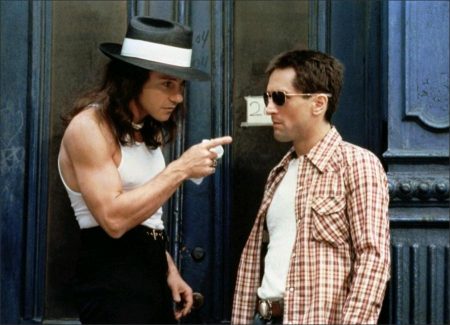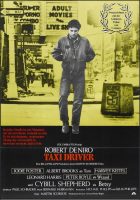Tagline: He’s a lonely forgotten man desperate to prove that he’s alive.
Taxi Driver movie storyline. Travis Bickle (Robert De Niro) is an ex-Marine and Vietnam War veteran living in New York City. As he suffers from insomnia, he spends his time working as a taxi driver at night, watching porn movies at seedy cinemas during the day, or thinking about how the world, New York in particular, has deteriorated into a cesspool. He’s a loner who has strong opinions about what is right and wrong with mankind.
For him, the one bright spot in New York humanity is Betsy, a worker on the presidential nomination campaign of Senator Charles Palantine. He becomes obsessed with her. After an incident with her, he believes he has to do whatever he needs to make the world a better place in his opinion. One of his priorities is to be the savior for Iris, a twelve-year-old runaway and prostitute who he believes wants out of the profession and under the thumb of her pimp and lover Matthew.
Taxi Driver (1976) is director Martin Scorsese’s and screenwriter Paul Schrader’s gritty, disturbing, nightmarish modern film classic, that examines alienation in urban society. Scorsese’s fourth film, combining elements of film noir, the western, horror and urban melodrama film genres. Historically, the film appeared after a decade of war in Vietnam, and after the disgraceful Watergate crisis and President Nixon’s resignation.
It explores the psychological madness within an obsessed, twisted, inarticulate, lonely, anti-hero cab driver and war vet (De Niro), who misdirectedly lashes out with frustrated anger and power like an exploding time bomb at the world that has alienated him. His assaultive unhinging is first paired with a longing to connect with a blonde goddess office worker (Cybill Shepherd), and then with an attempt to rescue / liberate a young 12-year old prostitute named Iris (Jorie Foster) from her predatory pimp “Sport” (Harvey Keitel) and her tawdry, streetwalking life. [The young Jodie Foster, who had previously acted for Scorsese in Alice Doesn’t Live Here Anymore (1974), was required to undergo psychological tests to see if she would bear up during filming.]
Taxi Driver has been acknowledged as consciously influenced by John Ford’s The Searchers (1956) – the story of another angry war veteran and social outcast who becomes obsessed during a search and rescue of his young niece from a long-haired Comanche chief named Scar. Ford’s film was about his fanatical quest to liberate the young girl, restore her virtue, and return her to society, in order to purify his own soul, although he remains an outsider.
Critically acclaimed upon release and nominated for four Academy Awards, including Best Picture, Taxi Driver won the Palme d’Or at the 1976 Cannes Film Festival. It is regularly cited by critics, film directors, and audiences alike as one of the greatest films of all time. In 2012, Sight & Sound named it the 31st-best film ever in its decennial critics’ poll, ranked with The Godfather Part II, and the fifth-greatest film of all time on its directors’ poll. The film was considered “culturally, historically or aesthetically” significant by the US Library of Congress and was selected for preservation in the National Film Registry in 1994.
About the Production
According to Scorsese, it was Brian De Palma who introduced him to Schrader. In Scorsese on Scorsese, the director talks about how much of the film arose from his feeling that movies are like dreams or drug-induced reveries. He admits attempting to incubate within the viewer the feeling of being in a limbo state somewhere between sleeping and waking. He calls Travis an “avenging angel” floating through the streets of a New York City intended to represent all cities everywhere. Scorsese calls attention to improvisation in the film, such as in the scene between De Niro and Cybill Shepherd in the coffee shop. The director also cites Alfred Hitchcock’s The Wrong Man and Jack Hazan’s A Bigger Splash as inspirations for his camerawork in the movie.
In Scorsese on Scorsese, the director mentions the religious symbolism in the story, comparing Bickle to a saint who wants to cleanse or purge both his mind and his body of weakness. Bickle attempts to kill himself near the end of the movie as a tribute to the samurai’s “death with honour” principle. When Travis meets Betsy to join him for coffee and pie, she is reminded of a line in Kris Kristofferson’s song “The Pilgrim, Chapter 33”: “He’s a prophet and a pusher, partly truth, partly fiction—a walking contradiction.” On their date, Bickle takes her to see a Swedish “sex education” film, which is in fact the American sexploitation film Sexual Freedom in Denmark with added Swedish sound.
Shot during a New York City summer heat wave and sanitation strike in 1975, Taxi Driver came into conflict with the MPAA for its violence (Scorsese de-saturated the color in the final shoot-out, and the film got an R rating). To achieve the atmospheric scenes in Bickle’s cab, the sound men would get in the trunk and Scorsese and his cinematographer, Michael Chapman, would ensconce themselves on the back seat floor and use available light to shoot. Chapman admitted the filming style was greatly influenced by Nouvelle Vague filmmaker Jean-Luc Godard and his cinematographer Raoul Coutard due to the fact the crew didn’t have the time nor the money to do “traditional things.”
In writing the script, Schrader was inspired by the diaries of Arthur Bremer (who shot presidential candidate George Wallace in 1972)[13] and Fyodor Dostoyevsky’s Notes from Underground. The writer also used himself as inspiration; in a 1981 interview with Tom Snyder on the “Tomorrow” show, Schrader related his experience living in New York City while battling chronic insomnia, which led him to frequent pornographic bookstores and theaters because they remained open all night.
Following a divorce and a breakup with a live-in girlfriend, he spent a few weeks living in his car. He wrote the script in under a month while staying in his former girlfriend’s apartment while she was away. Schrader decided to make Bickle a Vietnam vet because the national trauma of the war seemed to blend perfectly with Bickle’s paranoid psychosis, making his experiences after the war more intense and threatening. Thus, Bickle chooses to drive his taxi anywhere in the city as a way to feed his hate.
While preparing for his role as Bickle, De Niro was filming Bernardo Bertolucci’s 1900 in Italy. According to Boyle, he would “finish shooting on a Friday in Rome … get on a plane … [and] fly to New York.” De Niro obtained a cab driver’s license, and when on break would pick up a cab and drive around New York for a couple of weeks, before returning to Rome to resume filming 1900. De Niro apparently lost 35 pounds and listened repeatedly to a taped reading of the diaries of Arthur Bremer. When he had time off from shooting 1900, De Niro visited an army base in Northern Italy and tape-recorded soldiers from the Midwestern United States, whose accents he thought might be appropriate for Travis’s character.
Taxi Driver (1976)
Directed by: Martin Scorsese
Starring: Robert De Niro, Jodie Foster, Albert Brooks, Harvey Keitel, Leonard Harris, Peter Boyle, Cybill Shepherd, Diahnne Abbott, Victor Argo, Brenda Dickson, Harry Fischler
Screenplay by: Paul Schrader
Cinematography by: Michael Chapman
Film Editing by: Tom Rolf, Melvin Shapiro
Costume Design by: Ruth Morley
Set Decoration by: Herbert F. Mulligan
Art Direction by: Charles Rosen
Music by: Bernard Herrmann
Distributed by: Columbia Pictures
Release Date: February 8, 1976
Views: 205



